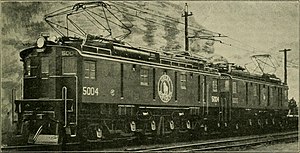GN-Klasse Z1
| Great Northern Railway Z-1 | |
|---|---|
 Z-1 Nr. 5004 und 5005 | |
| Nummerierung: | 5004–5013 |
| Anzahl: | 10 (5 Doppellokomotiven) |
| Hersteller: | Baldwin Locomotive Works, Westinghouse Electric |
| Baujahr(e): | 1926–1928 |
| Ausmusterung: | 1956 |
| Achsformel: | 1'Do 1' |
| Spurweite: | Normalspur (1.435 mm) |
| Dienstmasse: | 168 t |
| Stundenleistung: | 1.614 kW |
| Dauerleistung: | 1.365 kW (1.830 PS) |
| Dauerzugkraft: | 393 kN |
| Stromsystem: | 11 kV, 25 Hz |
| Stromübertragung: | Oberleitung |
Die Klasse Z-1 der Great Northern Railway umfasste zehn von Baldwin und Westinghouse gebaute Elektrolokomotiven mit der Achsformel 1'Do 1' für den Betrieb auf der elektrifizierten Bahnstrecke durch den Cascade Tunnel.
Geschichte
In den Jahren 1925 bis 1929 wurde durch die Great Northern ein neuer 12,5 Kilometer langer Cascade Tunnel unter dem Stevens Pass gebaut. Auch bei diesem Tunnel sollten auf Grund der mangelhaften Belüftung keine Dampflokomotiven eingesetzt werden.
Der gesamte elektrifizierte Abschnitt zwischen Wenatchee und Skykomish im US-Bundesstaat Washington war 117 km lang. Im Gegensatz zum bisher im alten Tunnel genutzten 6,6 kV 25 Hertz Drehstromsystem wurde im neuen Tunnel 11 kV 25 Hz Einphasenwechselstrom benutzt. Damit übernahm man die Erfahrung aus den erfolgreichen Tests mit dem gleichen System auf der Detroit, Toledo and Ironton Railroad. Für den Einsatz auf der neuen Tunnelstrecke mussten auch neue Lokomotiven erworben werden.
1926 wurden die ersten vier Lokomotiven geliefert. Der mechanische Teil wurde von Baldwin und der elektrische Teil von Westinghouse gefertigt. Diese Lokomotiven wurden als zwei fest gekuppelte Doppellokomotiven geliefert. Bis 1946 wurden nach und nach auch die anderen Lokomotiven paarweise zu Doppellokomotiven verbunden. Vier Lokomotiven konnten einen 2900-Tonnen-Zug über die Steigung von 2,2 % befördern.
Die beiden Doppellokomotiven erhielten anfangs die Nummern 5002A/B und 5007A/B, wobei der angehängte Buchstabe der Unterscheidung beider Lokhälften diente. Die anderen Lokomotiven erhielten die Nummern 5000–5001 sowie 5004–5007. Nach mehreren Umzeichnungen trugen die zwischenzeitlich alle zu Doppellokomotiven zusammengefassten Lokomotiven schließlich die Nummern 5000A/B, 5002A/B, 5004A/B, 5006A/B und 5008A/B.
Nachdem im Tunnel ein leistungsfähigeres Belüftungssystem installiert wurde, wurden 1956 alle Lokomotiven ausgemustert und verschrottet.
Technik
Es handelte sich um Umformer-Lokomotiven, bei denen der Wechselstrom aus der Oberleitung zunächst heruntertransformiert wurde und zwei Wechselstrommotoren antrieb. Diese trieben wiederum Gleichstromgeneratoren an, welche die vier Westinghouse 356-A Gleichstrom-Fahrmotoren versorgten.
Die Lokomotiven besaßen eine Mehrfachsteuerung sowie eine Nutzbremse.
Literatur
- William D. Middleton: When the steam railroads electrified. 2. überarbeitete Auflage. Indiana University Press, Bloomington, IN 2001, ISBN 978-0-253-33979-9 (amerikanisches Englisch).
Weblinks
Auf dieser Seite verwendete Medien
Autor/Urheber: Internet Archive Book Images, Lizenz: No restrictions
Identifier: railwaylocomotiv41newy (find matches)
Title: Railway and locomotive engineering : a practical journal of railway motive power and rolling stock
Year: 1901 (1900s)
Authors:
Subjects: Railroads Locomotives
Publisher: New York : A. Sinclair Co
Contributing Library: Carnegie Library of Pittsburgh
Digitizing Sponsor: Lyrasis Members and Sloan Foundation
View Book Page: Book Viewer
About This Book: Catalog Entry
View All Images: All Images From Book
Click here to view book online to see this illustration in context in a browseable online version of this book.
Text Appearing Before Image:
ger locomotives, rated at approximately 3000 horse-power each, which will be required for handling passen-ger trains of the New York Central and other roads inand out of this terminal. The design of this locomotive and Western Railway. This company has announcedthat the 3000-volt system will be used for the electrifica-tion of the Hoboken Terminal and Suburban zone, forwhich equipment will be in order during the comingyear. The selection of this system will permit extensionof the electric zone over the main line to Scranton withoutchange of trolley voltage. Another notable electrification has been completed dur-ing the year by the so-called Narrow Gauge—the Bos-ton. Revere Beach and Lynn Railroad. This road has beenan important passenger line for many years. It has beenelectrified to improve equipment, make faster schedulesand thus further increase the possible business. Thesteam locomotives have been replaced by electric motorcars, operated in trains of from two to eight cars each.
Text Appearing After Image:
Baldwin-Westinghouse Electric Locomotive on the Great Northern Railway includes two three-axle driving trucks, with six twin gearedmotors and a two axle guiding truck at each end of theunit. These locomotives will be capable of handling 1275-ton trains over the electric zone at an unusually highschedule speed. Two substations will be used for direct current powersupply, one containing three 3000-kilowatt synchronousmotor-generator sets and the other containing two simi-lar sets. Power will be purchased from the local powercompany. While the work being done at present is strict-ly a terminal electrification, the system selected will per-mit further extensions on the main line of the New YorkCentral at the same trolley voltage. An important decision was made recently regardingthe selection of a system- by the Delaware, Lackawana The existing passenger coaches have been equipped withmotor and control equipment, new lighting and heating,and are modern in every respect. A total of 60 cars
Note About Images
